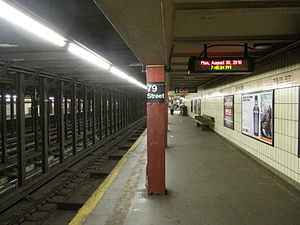79th Street station (IRT Broadway–Seventh Avenue Line)
79th Street | |||||||||
|---|---|---|---|---|---|---|---|---|---|
 Downtown platform | |||||||||
| Station statistics | |||||||||
| Address | West 79th Street & Broadway New York, NY 10024 | ||||||||
| Borough | Manhattan | ||||||||
| Locale | Upper West Side | ||||||||
| Division | A (IRT)[1] | ||||||||
| Line | IRT Broadway–Seventh Avenue Line | ||||||||
| Services | 1 2 | ||||||||
| Transit | |||||||||
| Structure | Underground | ||||||||
| Platforms | 2 side platforms | ||||||||
| Tracks | 4 | ||||||||
| Other information | |||||||||
| Opened | October 27, 1904[2] | ||||||||
| Opposite- direction transfer | No | ||||||||
| Traffic | |||||||||
| 2023 | 3,519,664[3] | ||||||||
| Rank | 90 out of 423[3] | ||||||||
| Station succession | |||||||||
| Next north | Template:NYCS next | ||||||||
| Next south | Template:NYCS next | ||||||||
| |||||||||
79th Street Subway Station (IRT) | |||||||||
| MPS | New York City Subway System MPS | ||||||||
| NRHP reference No. | 04001018[4] | ||||||||
| Added to NRHP | September 17, 2004 | ||||||||
79th Street is a local station on the IRT Broadway – Seventh Avenue Line of the New York City Subway. Located at the intersection of 79th Street and Broadway on the Upper West Side of Manhattan, it is served by the 1 train at all times and 2 train during late nights.
History
79th Street opened as part of the original subway on October 27, 1904, with service from Brooklyn Bridge to 145th Street. Subsequent extensions changed this routing to trains running down the entirety of the West Side of Manhattan with branches to Brooklyn, Harlem, and the Bronx.
Station layout
| Ground | Street level | Exit/entrance |
| Platform level | Side platform | |
| Northbound local | ← ← | |
| Northbound express | ← | |
| Southbound express | | |
| Southbound local | | |
| Side platform | ||

Like other local stations, 79th Street has four tracks and two side platforms. The two express tracks are used by the 2 train during daytime hours and the 3 at all times. At this point on the line, the center express tracks are slightly lower than the local tracks, particularly at the north end.
All fare control areas are on platform level and there are no crossovers or crossunders. The southbound platform is fully staffed, containing a turnstile bank, token booth, staircase going up to the northwest corner of West 79th Street and Broadway, and passageway separated from the platform by a steel fence leading to a staircase that goes up to the southwest corner of the aforementioned intersection. This passageway has a High Entry-Exit Turnstile to the platform and was added after the station's opening as proven by its cinder block tiles.
The northbound platform's fare control is unstaffed, containing a turnstile bank, now-closed customer assistance booth, staircase going up to the southeast corner of West 79th Street and Broadway, and passageway separated from the platform by a steel fence leading to a staircase that goes up to the northeast corner of the aforementioned intersection. This passageway has a High Exit-Only Turnstile to the platform and was also added after the station's opening.
Design and artwork
Both platforms have cream-colored tiles and a pink trim line with "79TH ST" written on it in black sans serif font at regular intervals. These tilings were installed during a 1970s renovation that covered most of the original mosaics and cartouches. Some of these as well as the decorated ceiling beams can still be seen by the fare control areas.
Gallery
-
Name in mosaics
-
Original wall decorations and mosaics
-
The uptown platform and control area in 1978
References
- ^ "Glossary". Second Avenue Subway Supplemental Draft Environmental Impact Statement (SDEIS) (PDF). Vol. 1. Metropolitan Transportation Authority. March 4, 2003. pp. 1–2. Archived from the original (PDF) on February 26, 2021. Retrieved January 1, 2021.
- ^ New York Times, Our Subway Open: 150,000 Try It, October 28, 1904
- ^ a b "Annual Subway Ridership (2018–2023)". Metropolitan Transportation Authority. 2023. Retrieved April 20, 2024.
- ^ "NPS Focus". National Register of Historic Places. National Park Service. Retrieved November 6, 2011.
- ^ "Facts and Figures: Annual Subway Ridership". Metropolitan Transportation Authority. Retrieved 2016-04-19.
External links
- nycsubway.org – IRT West Side Line: 79th Street
- Station Reporter — 1 Train
- Forgotten NY — Original 28 - NYC's First 28 Subway Stations (Part 2)
- 79th Street entrance from Google Maps Street View
- Platforms from Google Maps Street View





